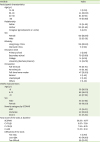1. Scottish Intercollegiate Guidelines Network (SIGN). Management of atopic eczema in primary care. SIGN 125. March 2011 [Internet]. Edinburgh: SIGN;2011. 03. cited 2019 Mar 19. Available from:
http://www.sign.ac.uk.
2. Sandilands A, Terron-Kwiatkowski A, Hull PR, O'Regan GM, Clayton TH, Watson RM, Carrick T, Evans AT, Liao H, Zhao Y, Campbell LE, Schmuth M, Gruber R, Janecke AR, Elias PM, van Steensel MA, Nagtzaam I, van Geel M, Steijlen PM, Munro CS, Bradley DG, Palmer CN, Smith FJ, McLean WH, Irvine AD. Comprehensive analysis of the gene encoding filaggrin uncovers prevalent and rare mutations in ichthyosis vulgaris and atopic eczema. Nat Genet. 2007; 39:650–654.

3. Kantor R, Silverberg JI. Environmental risk factors and their role in the management of atopic dermatitis. Expert Rev Clin Immunol. 2017; 13:15–26.

4. Shaw TE, Currie GP, Koudelka CW, Simpson EL. Eczema prevalence in the United States: data from the 2003 National Survey of Children's Health. J Invest Dermatol. 2011; 131:67–73.

5. Simpson CR, Newton J, Hippisley-Cox J, Sheikh A. Trends in the epidemiology and prescribing of medication for eczema in England. J R Soc Med. 2009; 102:108–117.

6. Guo Y, Li P, Tang J, Han X, Zou X, Xu G, Xu Z, Wei F, Liu Q, Wang M, Xiao F, Zong W, Shen C, Li J, Liu J, Luo Y, Chang J, Sheng N, Dong C, Zhang D, Dai X, Zhou J, Meng C, Niu H, Shi X, Zhang X, Xiang J, Xu H, Ran Q, Zhou Y, Li M, Zhang H, Cheng R, Gao X, Wang H, Gu H, Ma L, Yao Z. Prevalence of Atopic Dermatitis in Chinese Children aged 1-7 ys. Sci Rep. 2016; 6:29751.

7. Seeing The Invisible – Hong Kong's first community-wide program for children and families affected by childhood eczema [Internet]. Hong Kong: The University of Hong Kong;2017. 04. cited 2019 March 19. Avaialble from
https://www.hku.hk/press/news_detail_16241.html.
8. Magin P, Adams J, Heading G, Pond D, Smith W. Experiences of appearance-related teasing and bullying in skin diseases and their psychological sequelae: results of a qualitative study. Scand J Caring Sci. 2008; 22:430–436.

9. Basra MK, Sue-Ho R, Finlay AY. The Family Dermatology Life Quality Index: measuring the secondary impact of skin disease. Br J Dermatol. 2007; 156:528–538.

10. Finlay AY, Khan GK. Dermatology Life Quality Index (DLQI)--a simple practical measure for routine clinical use. Clin Exp Dermatol. 1994; 19:210–216.

11. Norwood SL. Research strategies for advanced practice nurses. Upper Saddle River (NJ): Prentice Hall Inc.;2000.
12. Raykov T, Marcoulides GA. A first course in structural equation modeling. 2nd ed. Mahwah (NJ): Erlbaum;2006.
13. Yarbrough KB, Neuhaus KJ, Simpson EL. The effects of treatment on itch in atopic dermatitis. Dermatol Ther (Heidelb). 2013; 26:110–119.

14. Portney LG, Watkins MP. Foundations of clinical research. Applications to practice. 3rd ed. Harlow (UK): Prentice Hall Inc.;2009.
15. Schmitt J, Langan S, Deckert S, Svensson A, von Kobyletzki L, Thomas K, Spuls P. Harmonising Outcome Measures for Atopic Dermatitis (HOME) Initiative. Assessment of clinical signs of atopic dermatitis: a systematic review and recommendation. J Allergy Clin Immunol. 2013; 132:1337–1347.
16. Kunz B, Oranje AP, Labrèze L, Stalder JF, Ring J, Taïeb A. Clinical validation and guidelines for the SCORAD index: consensus report of the European Task Force on Atopic Dermatitis. Dermatology. 1997; 195:10–19.

17. Pucci N, Novembre E, Cammarata MG, Bernardini R, Monaco MG, Calogero C, Vierucci A. Scoring atopic dermatitis in infants and young children: distinctive features of the SCORAD index. Allergy. 2005; 60:113–116.

18. Lewis-Jones MS, Finlay AY. The Children's Dermatology Life Quality Index (CDLQI): initial validation and practical use. Br J Dermatol. 1995; 132:942–949.

19. Chuh AA. Validation of a Cantonese version of the Children's Dermatology Life Quality Index. Pediatr Dermatol. 2003; 20:479–481.

20. Schwarzer R, Jerusalem M. Generalized self-efficacy scale. In : Weinman J, Wright S, Johnson M, editors. Measures in health psychology: a user's portfolio, causal and control beliefs. Windsor (UK): NFER-NELSON;1995. p. 35–37.
21. Schwarzer R, Bäßler J, Kwiatek P, Schröder K, Zhang JX. The assessment of optimistic self-beliefs: comparison of the German, Spanish, and Chinese versions of the general self-efficacy scale. Appl Psychol. 1997; 46:69–88.

22. Tabachnick BG, Fidell LS. Using multivariate statistics. 6th ed. Boston: Pearson Education;2013.
23. Cohen J. Weighted kappa: nominal scale agreement with provision for scaled disagreement or partial credit. Psychol Bull. 1968; 70:213–220.
24. Schermelleh-Engel K, Moosbrugger H, Müller H. Evaluating the fit of structural equation models: Tests of significance and descriptive goodness-of-fit measures. Method Psychol Res. 2003; 8:23–74.







 PDF
PDF Citation
Citation Print
Print





 XML Download
XML Download